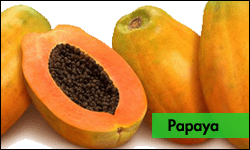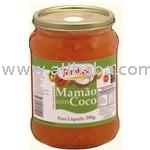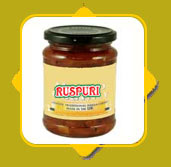Back to > Major Fruits | Minor Fruits | Underutilized Fruits
![]()
 |
||
|
|
||
Nutritional Values:
Papaya is also known as “the Fruits of the Angels” according to Christopher Columbus. It has a high content of vitamins A, E and C. Besides, vitamin C and A, both are needed for the proper function of a healthy immune system and preventing such illnesses as recurrent ear infections, colds and flu. Antioxidant components like a vitamin C, malic acid and citric acid also found in this fruit. Furthermore, papaya also contains K, Cu, P, Fe, Mg, carotenes, flavonoids, folate and panthothenic acid, and also fiber. These nutrients help to promote a healthy cardiovascular system and provide protection against colon cancer. Fiber has been shown to lower cholesterol level in human body. Papaya and its seeds have proven anti-parasitic and anti-amoebic activities, and their consumption offers a cheap, natural, harmless, readily available preventive strategy against intestinal parasites.
Fruit Nutrition Facts:
by serving size, 1 fruit:
| Fruit | Serving Size | Carbs (g) | Calories | Fiber (g) | Vitamin A (IU) | Vitamin C (mg) | Potassium (mg) | Folate (microg) |
| RDA* | n/a | 300 | 2000 | 25 | 5000 | 60 | 3500 | 400 |
| Papaya | 1 fruit (304g) | 29.8 | 119 | 5.5 | 3326 | 187.9 | 781 | 116 |
*RDA = recommended daily allowance, for adults, based on a 2000 calorie diet data is taken from USDA tests
By serving per 100g
| Fruit | Serving Size | Carbs (g) | Calories | Fiber (g) | Vitamin A (IU) | Vitamin C (mg) | Potassium (mg) | Folate (microg) |
| Papaya | 100g | 9.81 | 39 | 1.8 | 1094 | 61.8 | 257 | 38 |
Important phyto-chemicals
Digestion: Papaya, especially when green or unripe, contains papain, an enzyme that aids digestion. This protein-digesting enzyme is used as an ingredient in many meat tenderizers, and is also found in digestive enzyme dietary supplements. Papain is used to treat indigestion, chronic diarrhea and constipation, hay fever, sports injuries and allergies.
Papain: It is one of the most important phytochemical that we can get from this fruits. It also known as vegetable pepsin (digestive enzyme) and can be found in fruit latex and leaves (white latex). This white latex is come from the extraction of tree enzyme of papaya, pepsin. Commercially, the papain has varied industrial uses such in food making industry, production of chewing gum, in chill proofing beer and meat tenderizer to break down the protein. Besides, papain is also used in drug and anti-bacterial preparations for various digestive ailments and the treatment of gangrenous wounds and in cosmetic industry such as in shampoo and soap making. It also has been used in the textile industry, for degumming silk and softeningof wool. Furthermore, it also used like bromelain, a similar enzyme form in pineapple that can be used to treat sport injuries, other causes of trauma and allergies.
 Enzyme |
 Papaya-coconut Jam |
 Papaya Pulp |
Cardiovascular: The leaves of the papaya contain a component called carpaine, and preliminary studies have suggested it to be beneficial to cardiovascular health. Further research is needed to confirm these results.
Glycemic Index (GI): The glycemic index (GI) describes the difference by ranking carbohydrates according to their effect on our blood glucose levels. Eating a lot of high GI foods can be detrimental to our health because it pushes our body to extremes. Choosing low GI carbs – the ones that produce only small fluctuations in our blood glucose and insulin levels – is the secret to long-term health reducing our risk of heart disease and diabetes and is the key to sustainable weight loss. In a study to determine the GI of various fruits, it was concluded that papaya has an intermediate GI, neither high nor low.
Hypertension: Preliminary studies have concluded that papaya juice contains agents that reduce high blood pressure. Further studies are needed to substantiate this research.
Reference:
- Chong, S.T., R. Prabhakaran and H.K. Lee. ISHS Acta Horticulturae 787: International Workshop on Tropical and Subtropical Fruits.
- Lamberts, M. and J.H. Crane. 1990. Tropical fruits. p. 337-355. In: J. Janick and J.E. Simon (eds.), Advances in new crops. Timber Press,Portland,OR.
- Morton, J. 1987. Papaya. p. 336–346. In: Fruits of warm climates. Julia F. Morton,Miami,FL.
